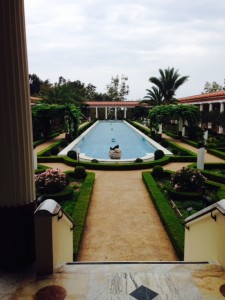How the Other Half Lived

I try not to drive further south than Santa Barbara unless there is a funeral or a sick friend. Once you get to Ojai, the highway splits into six lanes on either side and drivers grow another funny head on their shoulders that continually screams “Faster, Faster, Closer, Closer” until I want to scream, “Get me out of here!” Yet, there I was winding my way to Malibu on a hot July Monday on the way to my advance, timed ticket reservation at the Getty Villa, 11 am sharp please and rushing to get there on time. It wasn’t a funeral or a sick friend either. We were homeless this last summer awaiting the quarantine time to be over so we could fly the animals to our new next chapter in our Volcano Hawaii home. Our favorite cousin Karen lives close by so we spent a couple of weeks in her bedroom, she had the guest bedroom for clarification, and with Monday off work day for her, exploring and looking for great food and wine consumed the day.
Parking, a premium on the Coast Highway is all you pay for at the Museum. A flower lined, cobblestone road is hidden from the sea-road and check in with the attendants moves swiftly. The Villa’s main drive simulates the ancient street of Pompeii and Herculaneum, which were paved with large, irregular stones. Parking structures provide shaded parking with a short walk to the main entrance.
The Getty Villa is modeled after the Villa dei Papiri, a Roman country house in Herculaneum, buried by the eruption of mount Vesuvius in AD 79. J. Paul Getty purchased a sixty-four acre site in Malibu in 1945 and nine years later opened the original J. Paul Getty Museum in his home to exhibit his collection of Greek and Roam antiquities. In 1968, he decided to re-create a first-century Roman country house on the property to exhibit his growing collection of art. Seems reasonable to me.
Noticing a 12 minute long film exhibit near the entrance, we stopped to get a total picture of the property, a glimpse of the psyche of the man and rest from the walk up the hill. The Atrium, a large open ceiling or compluvium, raises the eyes to the open light, allowing rainwater to fall into the impluvium where it was channeled to an underground cistern. The day we visited was overcast and perfect for a stroll around the herb garden and outer peristyle. The formal gardens offer a variety of small sitting areas under draped foliage awaiting ancient Greek gatherings for political or social discussion. I was able to brush up on my ancient language skill as well.
Throughout the galleries with over 1,200 works of art from the museum’s permanent collection, there are organized rooms by themes including Gods and Goddesses, stories of the Trojan War and coins and jewels of the era. The week we visited a special installation of Glassmaking in Antiquity called Molten Color was a fascinating look at blown glass.
There are tour specific guided highlights regarding the architecture and gardens as well as a focus tour: thru the Curator’s Eye. The tours run at 10:30 and two times in the afternoon. Online reservations http://www.getty.edu/visit/villa/plan/hours.html and parking is $15.00 per vehicle.
Spend a few hours or the day at this magnificent, newly renovated site dedicated to the cultures of ancient Greece and Rome. Lunch is served on site. We opted to search the Coast Road for something different. Stay tuned for Geoffrey’s-Malibu.
